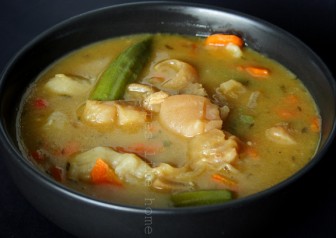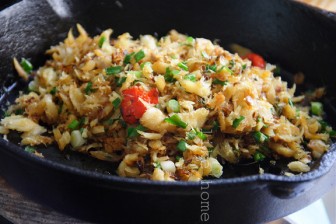Hi Everyone,
Last week, within a 48-hour period, I heard some food related things that I thought I’d share with you. I found them interesting, revealing and telling. Perhaps you share the same view, or, like me, you’ll learn something too.
Cooking with the
Pressure Cooker
to save gas
Three women were standing in an immigration line behind me and they were talking about cooking, catching fish, building their homes etc. One woman explained to her two companions how these days, she cooks almost everything in her pressure cooker. For her it is not only fast and easy but more importantly, it saves her gas!


Using a pressure cooker requires a certain degree of courage. There are countless stories of dangerous and horrible encounters people have had using pressure cookers. These days however, one need not be so afraid as pressure cookers are being made with more safety features and easy to use instructions.
However, a certain degree of intuition and know-how of pressure-cooking has to be involved if we are going to use a pressure cooker as an everyday cooking

vessel/tool. For example, having an idea of how much liquid to put in the pot, depending on what you are making, and what you want the results to be. Understanding what textures will be yielded from food cooked on high heat in a pressure cooker versus cooking on low heat and knowing the various cooking times for different ingredients.
Once you get the hang of using a pressure cooker though, you’ll wonder why it took you so long to get one. And perhaps like the lady, save on gas!
Hold the pork. I don’t want to touch it
I approached the Customs officer, gave him my customs form and proceeded to hoist my suitcase on to the counter and open it for inspection. Tucked away in my suitcase was an airtight container filled with bunjal (boon-jal) pork.
“What is the food you have?” he asked (I had indicated on the Customs form that I was bringing in food). “Cooked pork” I responded. The officer recoiled as if I had said something vile and disgusting. “Please hold the pork. I don’t want to touch it,” he said. I removed the container and he proceeded to prod and probe at the contents of my suitcase. “Nice woman like you killing yuh self,” he said. There was no need for me to ask for an explanation, I knew what he meant. The fact that I eat pork means I am going to die. I laughed at his comment and said, “And your Bajan passport should be taken away because Bajans are pork-loving people.”
As he continued to probe, the Customs officer came upon a neatly wrapped parcel. “What’s this?” he asked. “Fried fish” I replied. While he was clearly uncomfortable that he had touched the parcel, he wasn’t as repulsed as he was by the pork. “I tell you, you killing yuh self,” he repeated. I looked at him square in the face, and said, “You’re kidding me right? If I eat fish I am killing myself?” “I don’t touch none ah-dem tings so,” he said. “Well good for you!” I responded.
I hate it when vegetarians get all self-righteous about food and feel that they’re doing us omnivores some favour by judging and condemning what we eat.
Food is not food if
there is no meat
The taxi driver who transported me home engaged me in a conversation about tourism and how the officials are far removed from the reality and understanding of what tourists want. We talked about the lack of Caribbean dishes on the menus of many restaurants and then we started to talk about our own diets. I explained how I try to ensure that I have mostly vegetables during the week and relegate my meat eating to the weekends. His voice got soft as he said, “That’s something I know I need to include more in my meals – vegetables. But I got to tell you, for me, food is not food if there is no meat. I must have my meat. During the week, I eat mostly chicken and then on weekends the wife would cook some pork or lamb.”
He continued, “I don’t like chicken breast though.” I concurred, “It is the most boring part of the chicken. There must be some bones involved.” The driver said, “I like the legs first, thighs second and the wings last. Just don’t gimme no breast.”
I thought two things. One, how privileged it is to know and have available the parts of a chicken that you prefer while many people are content just to have any piece of chicken to eat. Secondly, I wondered at my order of preference for chicken. I don’t know that there is an order, except to say that the breast would always be a last choice, unless of course if the main dish is a chicken-breast dish, such as Chicken Kiev – a type of stuffed chicken breast.
Is there more than one
way to fry salt fish?
The following day I was at a meeting to discuss an upcoming arts festival in Barbados. Without giving too much details before the official launch, let me just say that there is going to be a little cooking contest – making salt fish and bakes. The head of the advertising committee asked, “Fried salt fish for the competition? Is there more than one way to fry salt fish?” As the resident food expert on the committee, the floor was mine to respond.
“Each Caribbean territory and as a matter of fact most homes right here in Barbados alone have different ways in which they fry salt fish. Some people like their salt fish fried dry with lots of onions and tomatoes; some with only onions. Some people put in things like sweet peppers, green onions and thyme while others don’t. Some people like their fried salt fish to be wet, have a little sauce. Others like their salt fish fried to the extent that there are bits of crisps. Some people prefer bone-in salt fish and cook it as such while others opt for boneless salt fish. Where there is a variety of salt fish, people prefer a particular type of fish as their salt fish because of the texture and flavour. Some like their salt fish flaked in to wholesome pieces while other prefer it fizzled into fine shreds. People even have different ways of de-salting their salt fish that they swear by.”
“Wow” the ad guy said. “I thought fried salt fish is just fried salt fish.”
I asked him how he liked his fried salt fish.
“Man I like mine wid a lot ah tamatas and de onions must be cut into long thin slices not chopped up into bits. I want some hot peppers chop up in there too and it must have a lil sauce, yuh know?”
I nodded and laughed heartily. “I know.” I remarked how his specificity had made the point that there is more than one way to fry salt fish.
Have a good weekend everyone.
Cynthia





